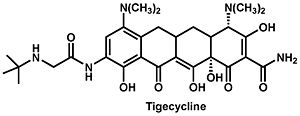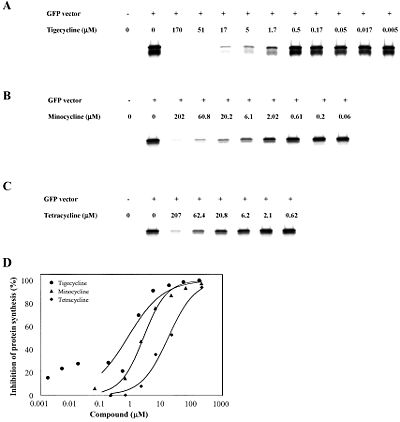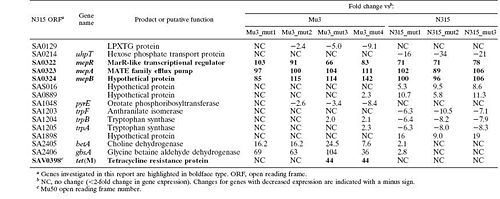Glycylcycline Antibiotics
Introduction
Kristina Buschur
The ability of bacteria to quickly develop resistance to commonly used antibiotics is a huge hurdle in the path of disease treatment. Because of this, there is an ever-present need to develop new antibiotics that are use novel mechanisms to overcome multidrug-resistance and prevent microbial growth. The glycylcycline class of antibiotics is such one recently-developed tool to combat this problem. Derived from tetracycline, glycylcyclines have added substituents that interfere with the mechanisms bacteria employ to resist tetracycline, such as tetracycline-specific efflux pumps and ribosomal protection proteins. Since tetracycline has been in wide use since the mid-1900s for treatment of many human and animal infections and as growth promoters in agriculture, many bacteria have since developed these mechanisms to prevent the harmful effects of tetracycline.
Currently tigecycline (previously GAR-936) is the only antibiotic of the glycylcycline class in clinical use. Tigecycline was approved by the Food and Drug Administration in 2005, and is particularly useful in the treatment of multi-drug resistant infections, which are especially hard to treat. Penicillin-resistant Streptococcus pneumoniae, methicillin-resistant Staphylococcus aureus and Staphylococcus epidermidis, and vancomycin-resistant Enterococcus species are several examples of species that have developed an antibiotic resistance but are still affected by tigecycline. In addition to these, there is a wide variety of organisms, including both gram-positive and gram-negative bacteria, that are sensitive to tigecycline. It does not, however, seem to have any effect of Proteus, Providencia, or Pseudomons species. The antibiotic is structurally very similar to minocycline and similarly binds to the bacterial 30S ribosome unit. The manner in which the molecule binds prevents amino-acyl tRNAs from binding to the A site of the ribosome and subsequently prevents peptide formation and bacterial growth. Furthermore, the main difference between tigecycline and minocycline is the addition of an N,N-dimethylglycylamido group which actually causes the molecule to bind to the ribosome up to five times more tightly and decreases the probability that resistance will develop.
The glycylcycline class of antibiotics is characterized by a molecular structure containing a four-ring carbocyclic skeleton with a substitution of an N-alkylglycylamido group at the D-9 position. Biochemical experiments have shown that the tigecycline binds to the same site on 16S rRNA as tetracycline but in a different orientation and with greater affinity. This has been confirmed by experiments in which a decreased binding affinity was observed in strains of E. coli with known mutations in the A site in the rRNA (G966U or G1058C).
Tigecycline is administered to a patient intravenously with a dose of 50 mg every 12 hours after an initial 100 mg loading dose. As with nearly all drugs, the antibiotic has several known side-effects, including nausea, vomiting, and diarrhea, but these are relatively minor. Barring any severe complications, the treatment period usually ranges from five to fourteen days.
Comparison of Tetracycline and Tigecycline Ribosome Binding
Bauer et al. have identified the binding sites of tetracycline and tegecycline through probing 70S E. coli ribosomes with dimethylsulphate (DMS) and Fe2+-mediated cleavage. This method works by allowing Fe2+ to replace Mg2+ complexed with tetracyclines. When H2O2 is added, the Fe2+ produces transient, very reactive hydroxy radicals that can cleave RNA close to where tetracycline is bound. It follows then, that the resulting cleavage sites will also be the location at which tetracycline binds to the ribosome. Crystallography experiments have shown that there are six tetracycline binding sites on the 30S ribosome.
It was found that three sites were cleaved in the rRNA in the presence of tetracycline. Two of the three sites, those in h31 and h34, corresponded with tetracycline binding site-1. These were confirmed through a point mutation (G1058 to C) in h34 that produced tetracycline resistance. Additional mutation experiments showed that mutations in these areas also resulted in an eight-fold increase in resistance to tigecycline. The third rRNA cleavage site in h29 corresponds to tetracycline binding site-4, so the observation is confirmed by crystallography data. There is, however, no evidence of a magnesium ion complexed with tetracycline at tetracycline binding site-2. It follows, then, that the Fe2+-mediated cleavage technique would not suggest a tetracycline at this site. The other tetracycline binding sites have previously shown no evidence of being involved in antibiotic activity.
With this knowledge, the authors conclude that since the three cleavage sites correspond to the physiologically important tetracycline binding sites and since the experiments produced identical results whether tetracycline or tigecycline was used, then tetracycline and tigecycline must share the same binding sites on 16S rRNA. Furthermore, tigecycline appears to bind much more tightly and at lower concentrations. There were, however, some differences in the Fe2+ cleavages intensities between tetracycline and tigecyclince. So although they do bind the ribosome in the same location, tigecycline likely binds in a different orientation than does tetracycline. The authors propose that the bulky t-butylglycylamido substituent at position 9 on tigecycline but lacking on tetracycline is responsible for this difference. To further investigate this, they compare the superimposed co-crystal structures of tetracycline and DMG-DMDOT (a glycylcycline derivative very similar to tigecycline) complexed with helices 31 and 34, which make up tetracycline binding site-1. This comparison revealed that the bulky dimethylglycylamido substituent on DMG-DMOT would clash with the phosphate backbone of G1053, forcing it to bind the ribosome differently. Likewise, the t-butylglycylamido substituent on tigecycline is even bigger and would presumably change the orientation in which tigecycline binds in a similar, if not more pronounced, way.
Antibacterial Activity of Tigecycline
In 2006, Olson et al. reported using functional, biophysical, and molecular modeling experiments to determine the way in which tigecycline demonstrates antibacterial activity. To investigate the effect of tigecycline, in comparison with tetracycline and minocycline, on bacterial protein synthesis, they used in vitro transcription/translation (IVT) assays in which E. coli cell lysate was supplied with a GFP vector and the amount GFP produced was measured with a phosphorimager. The results clearly show a pattern in which the amount of GFP produced decreases quickly as the concentration of tigecycline, minocycline, or tetracycline is increased, suggesting that each of these molecules inhibits translation. Furthermore, tigecycline started inhibiting translation at the lowest concentration, followed by minocycline then tetracycline. This would be expected as minocycline is a tetracyline derivative, and tigecycline is a minocycline derivative.
To further investigate the potency of these three drugs, competition studies very performed. They observed which of the antibiotics bound most effectively to both the 30S and the 70S subunits and found that tigecycline bound to both the 30S and 70S subunits with 5-fold greater affinity than minocycline and 100-fold greater affinity than tetracycline. Again, this trend is consistent with the structures of these molecules.
Finally, computational docking studies were performed to investigate the tigecycline-ribosome interaction. One particular position showed energetically favorable interactions that were consistent with all previous data. This position demonstrated favorable electrostatic, van der Waals, and hydrogen-bonding interactions with the 30S subunit that suggested it associated with the ribosome more closely than both minocycline and tetracycline. The overall orientation was very similar to that previously described for tetracycline, with the Mg ion interacting with the phosphate groups of G1197, C1054, and U1196. The most notable difference, though, was that the glycylcyclines interacted directly with other areas of the A site. These interactions included additonal hydrogen-bonding and van der Waals interactions that had never been seen before in that area.
Combined, these observations further support the conclusion of Bauer et al. that tigecycline sterically inhibits the binding of aminoacyl-tRNA to the A site of the ribosome in a manner very similar to that of tetracycline. Furthermore, their data suggests that the way in which glycylcyclines are able to avoid TetM-mediated resistance could be the result of either their increased affinity for binding the ribosome or the unique orientation in which they bind the ribosome that might make TetM ineffective in protecting the ribosome or some combination of the two.
Tigecycline Resistance Mechanisms
Despite its current success in preventing growth of bacterial species that have already developed resistance to tetracycline, it is inevitable that bacteria will eventually mutate so that they are resistant to tigecycline as well. McAleese et al. have found laboratory-derived mutants of Staphylococcus aureus that exhibit resistance to tigecycline and have traced that resistance to increased expression of the multidrug export protein mepRAB gene cluster. This cluster includes mepA, a novel MATE family efflux pump.
While there are no known naturally occuring isolates of S. aureus that show resistance to tigecycline, two such mutants were found by serial passages through increasing concentrations of the antibiotic, one derived from the Mut3 strain and one from the N315 strain. The bacteria that resulted from this procedure had a very much reduced sensitivity to tigecycline. A susceptibility profile of the mutants was performed to determine if the sensitivity to other antibiotics had decreased as well, which might suggest a more general resistance mechanism was at work. They found that both of the mutants were more resistant to DMG-MINO and DMG-DMDOT, two other glycylcylcline antibiotics very similar to tigecycline. Interestingly, the N315 mutant also showed increased resistance to EtBr and TPP.
A transcriptional profile analysis was undertaken to determine the origin of the decreased susceptibility observed in these mutants. S. aureus GeneChips were used to compare the DNA and RNA profiles of the Mu3 and N315 with their tigecycline-resistant mutants. They looked for changes in DNA content or gene expression that could explain the increased resistance. The found no changes in the DNA present in the mutants from the parent strains, suggesting that the mutants hadn't lost any genes that might be causing them to be susceptible to the antibiotic. The technique, though, was not sensitive enough to detect point mutations or small deletions. RNA was harvested from the parent and mutant strains during mid-exponential growth to compare their transcriptional profiles. Fifteen genes were found (some of them only hypothetical) whose transcription saw at least an eight-fold difference between the parent and the mutant. Among these genes was mepA, an efflux pump-encoding gene. Additionally, tetM, a tetracycline resistance gene, was overexpressed in Mu3_mut3 and Mu4_mut4. Both these genes seemed likely to be involved in the observed change in tigecycline sensitivity, and the group chose these genes to investigate further.
The gene cluster mepRAB was overexpressed by 100-fold in both the Mu3 and N315 mutants. A BLAST analysis showed that mepR encodes a MarR-like transcription regulator, mepA encodes an multidrug and toxin extrusion (MATE) family efflux pump, and mepB encodes a protein of unknown function. To confirm the effect of overexpression of mepA, a multicopy plasmid containing the gene was inserted into the parent strains. This resulted in a four-fold increase in the MIC of tegicycline, a measure of resistance to the antibiotic. This suggests that the bacteria are likely using the mepA efflux pump to export tigecycline from their cells.
The tetM gene was overexpressed in two of the four Mu3 mutants. They attributed this to a 87-bp deletion in the tetM promoter region that removed a stem-loop-forming region that likely regulated the gene by allowing for transcription attenuation. The loss of this region would cause the gene to be overexpressed. Experiments similar to those used to test the effect of mepA overexpression were carried out to determine the effect of TetM on tigecycline susceptibility. They found that TetM alone was not enough to produce resistance to tigecycline. Even in combination with the MepA efflux pump, no additional resistance to tigecycline seemed to be produced by the overproduction of TetM, suggesting that even though both mutations were present in these strains, they do not seem to work synergistically. Also, this shows that tigecycline seems to be able to completely resist the effects of TetM, giving it a distinct advantage over tetracycline for use in treating infections.
Conclusion
Overall paper length should be 3,000 words, with at least 3 figures.
References
Edited by student of Joan Slonczewski for BIOL 238 Microbiology, 2009, Kenyon College.




